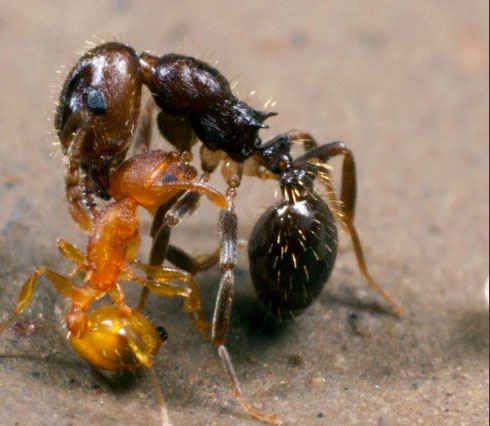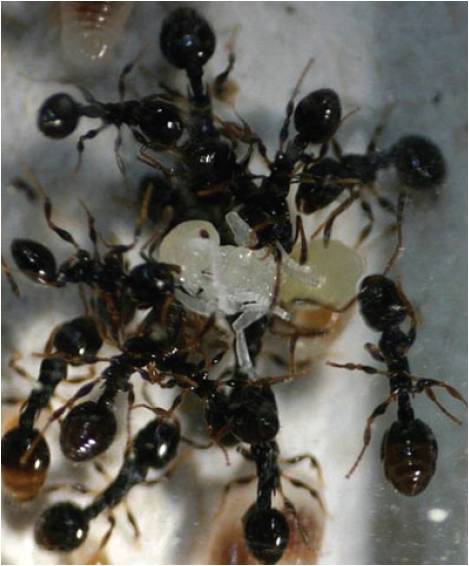Phenomenon of Slave-Making Behavior in Ants
Biology 342 Fall 2014
Emma Schweitzer & Rob Haas
| Home | Phylogeny | Ontogeny | Mechanism | Survival Value | References | Courses Home |
Survival Value
Survival Value, also called adaptive value, constitutes the physical features and behavioral characteristics of an animal or an animal population that impact the fitness of the individual or community. The most specialized adaptive value behavior of P. americanus is their ability to enslave L. longispinosus and other Leptothorax ant colonies, utilizing them as workers and scouts for their purposes of raiding and defending against other slave-making ants.
Social Parasitism
Social Parasitism is defined as living at the expense of a host, and is exemplified in slave-making ants. This has adaptive value for slave making ants because it means they benefit from harvested resources enslaved ants work to provide, and are thus able to allocate their attention and energy to their scouting, raiding, and slave rearing techniques. Two types of slave rearing mechanisms have been noted in these slave-driving ant populations: inquiline and dulosis. The inquiline method consists of an ant or any other type of animal exploiting the habitation and living space of another animal (not necessarily the same specie), whereas the dulosis method is the practice of slave-making ants to capture the pupae of other ant colonies and exploit them as workers in their own colony. Slave-making ants are known to use one or both the slave rearing mechanisms in their process to transition and rear their captive colonies. The P. americanus ant has been established as using both inquiline and dulotic methods to reorganize host colonies they have successfully raided.

Figure 1. P. americanus ant being bitten by a Temnothorax sp. ant. Visual example of how attacks and aggressive interactions might occur during scouts or raids.
Piggybacking off of other ants’ work benefits the P. americanus because they can rely on others to do work and expend energy for them, and submitting to this submissive role benefits the L. longispinosus so they might assimilate with less aggression and killing of their own community. P. americanus rely on their hosts to forage for food, scout other possible host colonies, nest build and care for both the leftover Leptorothax pupae as well as the new P. americanus queen’s pupae. Though it might seem that the power is shifted almost 100% in favor of the P. americanus ants, the behavioral roles of the slave-made L. Longispinosus also come in to play to check and balance their enslavers’ power. Roles and the tension between the host and parasite colony are suggested to be at odds for as long as cohabitations continues, the P. americanus receive many benefits and more food resources, the L. longispinosus have been observed to maintain and keep their parasitic authority population in check by systematically killing the P. americanus pupae broods that they are in charge of. This behavior of resource allocation and slave rebellion is believed to ensure that some appropriate balance is kept in check. This proposed parasite-host equilibrium is believed to be adaptive in maintaining the dynamics of slave-making ant colonies, ensuring that an appropriate slave-maker : slave-made ant ratio is kept.

Figure 2. Slave-made worker ants working to kill a slave-maker pupae.
Survival Value Considering Reproductive Success - Lifetime Reproductive Fitness (LRF)
One way to measure adaptive value is to look at the degree to which a species is reproductively fit, i.e. to pass on genes to a number of offspring that may also spread the same genetic material. Seguing from the slave rebellion behavior of killing slave-making ant pupae, this is rather tricky in the case of the slave-making ants P. americanus, since they rely on both the reproductive success from their hosts L. longispinosus. However, one identified reproductive survival value is seen with the P. americanus queen ant is that resources are amply supplied to her with little to no food fighting or resource competitive behaviors observed between her and worker ants of Protomagnuthus or Leptothorax species in the nest. While this food fighting is discussed more in other sections of this website (Ontogeny), the minimized energy expenditure to obtain food by the queen ant is advantageous so that she may spend more time on reproducing P. americanus larvae with plenty of resources available to her, which is markedly different from the Leptothorax reproductive abilities, which are more limited due to fewer resources and more energy expenditure. This allows her to steadily keep generating more pupae to make up for the fact that some of her pupae are killed in slave-rebellion pupae-cide.